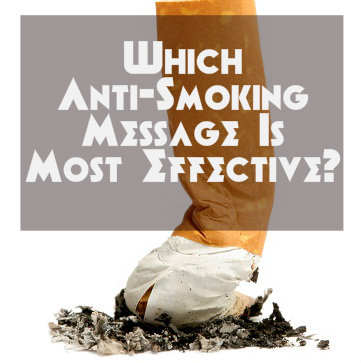Some people take the time to weigh the potential costs and benefits of participating in a given activity before deciding what to do. Social scientists and researchers refer to this forward-thinking outlook as a future orientation or a future-oriented time perspective. In a study scheduled for publication in July 2014 in the journal Addictive Behaviors, researchers from Canada’s University of Waterloo sought to determine how a future orientation helps predict the likelihood that any given person will succeed in the attempt to quit smoking. These researchers concluded that a couple of key factors help explain the smoking cessation-related benefits of a future-oriented time perspective.
Nicotine Addiction And Smoking Cessation
 According to figures compiled by the Centers for Disease Control and Prevention, most of the people who smoke cigarettes in the U.S. are physically dependent on nicotine, the main active ingredient in all types of tobacco. Unfortunately, for a number of reasons, nicotine dependence/addiction is fairly easy to acquire and fairly hard to overcome. Doctors, addiction specialists and public health officials refer to the attempt to stop smoking cigarettes as smoking cessation. More than two-thirds of American cigarette smokers openly express a desire to stop smoking entirely and establish a long-term nicotine-free lifestyle. In line with this fact, millions of Americans make an effort at smoking cessation every year; however relatively few people successfully quit smoking for more than a few days or weeks.
According to figures compiled by the Centers for Disease Control and Prevention, most of the people who smoke cigarettes in the U.S. are physically dependent on nicotine, the main active ingredient in all types of tobacco. Unfortunately, for a number of reasons, nicotine dependence/addiction is fairly easy to acquire and fairly hard to overcome. Doctors, addiction specialists and public health officials refer to the attempt to stop smoking cigarettes as smoking cessation. More than two-thirds of American cigarette smokers openly express a desire to stop smoking entirely and establish a long-term nicotine-free lifestyle. In line with this fact, millions of Americans make an effort at smoking cessation every year; however relatively few people successfully quit smoking for more than a few days or weeks.
There are several scientifically proven methods to increase the odds of achieving and maintaining smoking abstinence, including nicotine replacement therapy, use of non-nicotine-based medications such as Chantix (varenicline) or Zyban (buproprion), and non-medication-based approaches such as in-person or remotely delivered behavioral therapy and informative sessions called brief interventions. However, most people in the U.S. who try to quit smoking do not rely on one of these well-tested options.
Time Perspective And Future Orientation
As a rule, most people primarily focus their thoughts and actions on events that happened in the past, events happening in the present or events that may occur in the future. The frame of reference in use determines any given individual’s time perspective. Two of the time perspectives have a particular bearing on substance use, abuse and addiction: a hedonistic view of the present and a future-oriented perspective that emphasizes the benefits of delayed gratification. Generally speaking, people who have a hedonistic perspective on the present value impulsive actions and short-term rewards over carefully considered actions and long-term rewards. Conversely, people who have a future-oriented perspective value carefully considered actions and long-term rewards over impulsive actions and short-term rewards.
Time Perspective’s Impact On Smoking Cessation Success
Doctors and researchers know that people with a future-oriented perspective commonly receive long-term benefits in the form of improved or well-maintained health. Smoking cessation success is one of these potential health benefits. In the study published in Addictive Behaviors, the University of Waterloo researchers used a large-scale survey of smokers living in Canada, the U.S., Great Britain and Australia to investigate exactly why future orientation has a positive influence on smoking cessation attempts. All told, this survey included information from 9,772 people; it covered topics that included the day-to-day time perspective of each participant, each participant’s level of personal motivation to quit smoking, the number of quit attempts over an eight-year period of time and the relative success of any quit attempts during the same time frame.
After analyzing the survey results, the researchers confirmed that cigarette users with a future-oriented time perspective successfully quit smoking more often than their counterparts who don’t have a future-oriented perspective. When they looked at the underlying reasons for the different outcomes in the two types of smokers, they found that the future-oriented individuals who successfully stopped smoking typically had a higher level of motivation during the cessation process and sustained their active participation in this process for longer amounts of time.
The authors of the study published in Addictive Behaviors note that their project is the first attempt to explore the link between future orientation and smoking cessation success in current or recent smokers located in more than one country. In addition, they note that the link between a future-oriented time perspective and success in smoking cessation was found in all four countries under consideration. The study’s authors believe that the two factors uncovered during the study—heightened motivation and sustained participation during quit attempts—may be the main explanatory factors for the positive outcomes in future-oriented smokers.
How Stimulant And Smoking Addictions Can Be Treated Together
Call Us Now To Break Free From Your Addictions!
28 Jul 2014
Why Smokers Know About Quitlines, But Don’t Call
Smoking quitlines are telephone-based services that provide support and advice for people trying to kick the habit. In combination with the care provided by an addiction specialist or other qualified health professionals, use of one of these services can significantly increase the chances that a current cigarette user will successfully stop smoking. In a study published in May 2014 in the journal Nicotine & Tobacco Research, researchers from three U.S. institutions used information from a project called the National Adult Tobacco Survey to estimate how many U.S. smokers know that smoking quitlines exist.
 In the majority of cases, adult and teenage users of cigarettes in the U.S. and throughout the world are addicted to nicotine. Nicotine addiction is common among smokers, in part, because of the need to use the drug repeatedly in order to keep feeling its desired effects on the brain’s pleasure levels. Once a nicotine addiction is established, frequently repeated brain exposure to the drug also helps account for the difficulties that commonly appear during smoking cessation attempts. In fact, even people who eventually quit smoking typically fail to break their reliance on cigarettes/nicotine at least once.
In the majority of cases, adult and teenage users of cigarettes in the U.S. and throughout the world are addicted to nicotine. Nicotine addiction is common among smokers, in part, because of the need to use the drug repeatedly in order to keep feeling its desired effects on the brain’s pleasure levels. Once a nicotine addiction is established, frequently repeated brain exposure to the drug also helps account for the difficulties that commonly appear during smoking cessation attempts. In fact, even people who eventually quit smoking typically fail to break their reliance on cigarettes/nicotine at least once.
Addiction specialists and public health officials know that the odds of achieving smoking cessation success go up sharply for people who seek professional help and use one of the proven methods for quitting smoking. These methods include nicotine replacement therapy, the use of either of two nicotine-free medications called buproprion (Zyban) and varenicline (Chantix), and the use of any of several forms of behavioral therapy or counseling.
Smoking Quitlines
Some people aren’t sure exactly where to turn when they make the decision to stop smoking. Others may lack some or all of the resources needed to secure help from a doctor or involvement in a smoking cessation program. Smoking quitlines are publicly available options that provide smoking cessation-related information and advice to anyone interested in pursuing smoking cessation, regardless of considerations such as place of residence or level of income. All 50 states in the U.S. have such quitlines established, the National Cancer Institute’s Smokefree.gov reports. In addition, some quitlines operate nationally. As a rule, state and national quitlines employ counselors specifically trained to give advice remotely and direct callers to appropriate sources of support in their local areas.
How Many Smokers Know About Quitlines?
The National Adult Tobacco Survey (NATS) is a nationwide project that tracks tobacco use rates, and also tracks the underlying factors that make it more or less likely that any given person will start smoking or continue to smoke after initiating cigarette use. In the study published in Nicotine & Tobacco Research, researchers from the Centers for Disease Control and Prevention, Emory University and UC San Diego used data from the most recent version of NATS (conducted in 2009 and 2010) to estimate how many smokers in the U.S. know that smoking quitlines exist. The researchers also used the NATS data to identify the demographic factors (racial/ethnic background, gender, socioeconomic standing, etc.) that make it more or less likely that any particular smoker will know about quitlines. In addition to checking awareness levels among current smokers, they checked awareness levels among people who used to smoke and people who had never smoked.
The researchers concluded that more than half (53.9 percent) of current smokers know that smoking quitlines exist. In addition, 34 percent of ex-smokers and 27 percent of people with no history of smoking know about quitlines. Among active smokers who try to quit, the groups most likely to know that smoking quitlines exist are women, people who have recently visited a doctor and people who live in states that devote considerable amounts of money to anti-smoking efforts. Conversely, the groups of active smokers interested in quitting who are least likely to know that smoking quitlines exist include people who make less than $50,000 a year, African Americans and other people of non-Hispanic/Latino descent.
Who Is Most Likely To Use A Smoking Quitline?
Despite the respectable level of awareness of smoking quitlines among active smokers, the authors of the study found that only 7.8 percent of active smokers who attempt to stop using cigarettes call a quitline. The groups of active smokers most likely to utilize a quitline are people who receive advice from a doctor, people who live in states with well-funded anti-smoking programs and African Americans and other people of non-Hispanic/Latino descent. Older adults form the single group of active smokers least likely to contact a smoking quitline. The study’s authors note that awareness of smoking quitlines among active smokers varies widely from state to state.
Discover Which Anti-Smoking Message Is Most Affective On Smokers?
People diagnosed with some form of mental illness have steeply increased odds of smoking cigarettes. Doctors and researchers have proposed a range of underlying mechanisms to explain this connection between cigarette use and mental health issues. In a study published in April 2014 in the journal European Addiction Research, a team of Dutch researchers investigated how blood levels of a nicotine byproduct called cotinine affect any given person’s risks for having diagnosable problems with depression or an anxiety disorder.
Almost 20 percent of American adults have some form of diagnosable mental health problem. A similar percentage of the total adult population smokes cigarettes. However, current figures indicate that more than a third of U.S. adults with a mental illness diagnosis are smokers.
Additional Groups That Have A Greater Chance Of Smoking
In addition, researchers know that certain segments of the larger population of mentally ill adults have unusually heightened odds of being smokers, including younger individuals, those with relatively little educational achievement, people living in poverty and people with an Alaska Native or American Indian racial/ethnic background.
Explanations for the link between mental illness and smoking that have at least some scientific support include a tendency among people diagnosed with mental health problems to use cigarettes as a form of self-medication, an increased tendency toward mental illness among people who smoke and an increased tendency for smokers to use alcohol or other substances that carry their own separate mental health risks.
Nicotine And Cotinine
 Nicotine is the addictive substance responsible for fostering the patterns of repeated cigarette use common among smokers. Any given cigarette contains roughly 1 to 2 mg of nicotine, the federal Centers for Disease Control and Prevention report. This nicotine travels through the bloodstream to the brain, where it produces its mind-altering and addiction-promoting effects. After producing these effects, the drug does not immediately leave the body.
Nicotine is the addictive substance responsible for fostering the patterns of repeated cigarette use common among smokers. Any given cigarette contains roughly 1 to 2 mg of nicotine, the federal Centers for Disease Control and Prevention report. This nicotine travels through the bloodstream to the brain, where it produces its mind-altering and addiction-promoting effects. After producing these effects, the drug does not immediately leave the body.
Instead, it lingers in the bloodstream for a number of hours before breaking down into its main byproduct, cotinine. Cotinine stays in the body much longer than nicotine, and is therefore easier to trace. For this reason, in laboratory experiments, researchers commonly use the level of cotinine in a person’s bloodstream to track his or her involvement in cigarette use. While this byproduct always stays in the body longer than nicotine, the rate of cotinine processing varies from person to person.
How Smokers’ Cotinine Levels Affect Mental Illness
In the study published in European Addiction Research, researchers from three Dutch institutions explored the role of cotinine levels in determining which cigarette users have increased chances of developing diagnosable symptoms of major depression or another depressive disorder, or symptoms of any one of the conditions known collectively as anxiety disorders (panic disorder, general anxiety disorder, social phobia, etc.).
The data for this exploration came from 1,026 cigarette-using adults enrolled in a project called the Netherlands Study of Depression and Anxiety. All told, 692 of these cigarette users had active symptoms of a depressive disorder or an anxiety disorder. Another 190 study participants had a previously diagnosed case of depression or anxiety currently in remission, while the remaining 144 participants had no history of diagnosable depression or anxiety.
The researchers calculated the number of cigarettes smoked on a daily basis by each study participant, as well as the amount of cotinine found in the bloodstream after cigarette use occurred. After completing these calculations, they concluded that, for any given amount of cigarettes smoked, those individuals with relatively low levels of cotinine in their bloodstreams have the highest chances of experiencing diagnosable symptoms of anxiety or depression. The difference in cotinine levels is especially stark between those individuals currently affected by depression or anxiety and those individuals who have never had symptoms of these mental health problems.
The authors of the study published in European Addiction Research believe that smokers affected by a depressive disorder or an anxiety disorder may process the cotinine left over in their bloodstreams at a substantially faster pace than smokers not affected by depression or anxiety.
In turn, they believe that this faster cotinine processing may help provide an underlying reason for the relatively high daily cigarette intake among anxious and/or depressed smokers, as well as an underlying reason for the relatively poor smoking cessation outcomes for anxious and/or depressed cigarette users who try to quit.
See How The Odds For Quitting Smoking Triple With Counseling And Medication
According to the Centers for Disease Control and Prevention, tobacco use is the leading preventable cause of death in the United States. This is why helping people quit smoking is such a priority. Unfortunately, most smokers find it very hard to give up the habit. The Smoking Treatment for Ontario Patients (STOP) program—funded by the Ontario Ministry of Health and Long-Term Care—is one approach that manages to increase quit-rates by providing nicotine patches and psychological treatment to smokers, and could serve as an example for U.S.-based organizations. The initiative started in 2005 and now runs numerous times per year, offering smokers the opportunity to break free of their addictions and get healthy.
Why Is It So Hard To Quit Smoking?
 Although tobacco is a widespread and legal substance, quitting it is hard for many of the same reasons that it’s difficult to stop using illegal drugs. Nicotine—the addictive component of cigarettes—releases dopamine in the brain, the neurochemical responsible for the majority of addictions. When the body gets accustomed to it, the external “boost” that smoking provides stops, and this leads to an imbalance in brain chemicals followed by unpleasant symptoms. The problem is compounded by the fact that research indicates “cold turkey” (unsupported) quitting is the most popular method, but is a considerably less successful strategy than counseling, medications and nicotine replacement therapy (like gums or patches). In short, smokers—with an already difficult task ahead of them—often try to quit by themselves, which is statistically the least successful method.
Although tobacco is a widespread and legal substance, quitting it is hard for many of the same reasons that it’s difficult to stop using illegal drugs. Nicotine—the addictive component of cigarettes—releases dopamine in the brain, the neurochemical responsible for the majority of addictions. When the body gets accustomed to it, the external “boost” that smoking provides stops, and this leads to an imbalance in brain chemicals followed by unpleasant symptoms. The problem is compounded by the fact that research indicates “cold turkey” (unsupported) quitting is the most popular method, but is a considerably less successful strategy than counseling, medications and nicotine replacement therapy (like gums or patches). In short, smokers—with an already difficult task ahead of them—often try to quit by themselves, which is statistically the least successful method.
Physical Withdrawal Symptoms Of Nicotine Withdrawal
Like with other drugs, when you stop consuming nicotine you may feel a wide range of physical symptoms. The most common smoking withdrawal symptoms are agitation, irritability, weight gain, depression and anxiety. The negative symptoms come on because the individual is no longer getting the nicotine he’s become dependent on, and the brain knows it, creating cravings in an attempt to make the individual succumb to temptation and give it another hit of nicotine.
Psychological Challenges Of Quitting Smoking
Although the physical withdrawal symptoms add to the discomfort of quitting smoking, the psychological effects are what drive many ex-smokers to relapse. Smoking, like other drug addictions, is a poor coping strategy for dealing with everyday problems, and when these problems return, the individual is at particular risk for relapse. Both internal and external “triggers” to smoke can make the process more difficult, with internal factors including things like stress and depression and external ones including things like being around a friend who smokes or taking a work break that you previously used for smoking. These things push the individual back to smoking, and in combination with the physical withdrawal symptoms, they make the process of quitting extremely challenging.
Benefits Of Initiatives Like STOP
These issues are what make initiatives like STOP so worthwhile. The core selling point of STOP is that attendees receive five weeks’ worth of free nicotine patches, which ordinarily cost around $30 per week, meaning they save around $150. This removes what some see as a financial barrier to getting the support they need, but the support also takes the psychological elements into account. Each qualifying smoker is also eligible to attend workshops and receive ongoing support to help manage triggers and cravings.
This broad range of support contributes to the impressive success rates enjoyed by the initiative. Oxford County’s tobacco control coordinator Dominique Bruce points out that those in the program have a quit rate that’s 50 percent higher than those not in the program. She also points to the cost savings and psychological support offered by the program. “If you slip up, you need to remember it’s just a slip up, not a fail,” Bruce said.
The Right Way To Help People Quit Smoking
There are many lessons that can be learned from programs like STOP, and although this initiative is in Canada, U.S.-based stop smoking initiatives can take a cue from the approach and work to reduce the preventable diseases and deaths caused by smoking. The smokers themselves face the biggest challenges, but with the right support and the guidance to help them push through the difficult periods, they have the ability to kick their tobacco addiction for good. As long as we understand the challenges inherent in quitting smoking—or kicking any addiction—we can find the compassion to help those in need and the wisdom to do so in the most effective way possible.
Smoking cessation messages are public health advertisements and campaigns designed to encourage current smokers to stop using cigarettes, which contain the addictive substance nicotine. Some of these ads and campaigns focus on the steps required to quit smoking, while others focus on the reasons for quitting smoking. In a study published in March 2014 in the American Journal of Health Promotion, a team of American researchers compared the effectiveness of “how-you-can-quit” smoking cessation messages to the effectiveness of “why-you-should-quit” messages as motivations for actually attempting to cease cigarette intake.
Get The Anti-Smoking Message
 An agency inside the U.S. Department of Health and Human Services called the Substance Abuse and Mental Health Services Administration uses nationwide, annual survey information to track smoking rates among U.S. adults and teenagers. All told, about 22 percent of Americans in this broad age range smoke cigarettes each month. The peak smoking rate of 34.1 percent occurs among people between the ages of 21 and 25. People between the ages of 26 and 29 have a slightly lower smoking rate of 33.4 percent; in addition, close to a third (31.9 percent) of individuals between the ages of 30 and 34 smoke cigarettes. Three other segments of the population (people between the ages of 18 and 20, people between the ages of 35 and 39, and people between the ages of 45 and 49) also have a monthly smoking rate of over 25 percent. The monthly smoking rate drops below 20 percent only in adults age 60 or older and in children 17 and younger.
An agency inside the U.S. Department of Health and Human Services called the Substance Abuse and Mental Health Services Administration uses nationwide, annual survey information to track smoking rates among U.S. adults and teenagers. All told, about 22 percent of Americans in this broad age range smoke cigarettes each month. The peak smoking rate of 34.1 percent occurs among people between the ages of 21 and 25. People between the ages of 26 and 29 have a slightly lower smoking rate of 33.4 percent; in addition, close to a third (31.9 percent) of individuals between the ages of 30 and 34 smoke cigarettes. Three other segments of the population (people between the ages of 18 and 20, people between the ages of 35 and 39, and people between the ages of 45 and 49) also have a monthly smoking rate of over 25 percent. The monthly smoking rate drops below 20 percent only in adults age 60 or older and in children 17 and younger.
What Are Smoking Cessation Messages?
All smoking cessation messages have a target audience. In some cases, this audience is fairly broad and includes smokers from a range of backgrounds and segments of the population. In other cases, the target audience for a message is fairly narrow and includes only a single segment of the larger group of teen or adult smokers. In addition, some messages appear in isolation while others appear as part of larger, coordinated campaigns that continue for extended periods of time. Smoking cessation ads and campaigns can come from private institutions or from various levels of county, state or federal government. In addition, they can appear in a number of media settings, including TV, print or online outlets. Examples of recent campaigns undertaken on a national level include Tips from Former Smokers (from the Centers for Disease Control and Prevention) and Smokefree Teen (from the National Institutes of Health).
Which Anti-Smoking Messages Work?
In the study published in the American Journal of Health Promotion, researchers from an organization called RTI International used information gathered from 3,002 smokers age 18 or older to determine which smoking cessation messages have the greatest ability to foster quit attempts. The information-gathering sessions took place between late 2010 and early 2011; during these sessions, the study participants were exposed to two basic types of smoking cessation messages: those that focused on the ways in which smokers can halt cigarette use and those that focused on the real-world reasons for halting cigarette use. In turn, the “why-you-should-quit” messages were broken down into those that contained testimonials from other smokers and those that contained images demonstrating serious smoking-related health harms. Some participants viewed only one type of smoking cessation message, while others viewed various combinations of messages.
The researchers concluded that, compared to smokers who don’t view any smoking cessation messages, smokers who view only “why-you-should-quit” messages—or a combination of “why-you-should-quit” and “how-you-can-quit” messages—are significantly more likely to change their viewpoints on cigarette use and adopt a more pro-cessation outlook. They also concluded that, compared to smokers who don’t view any smoking cessation messages, most of the smokers who see “why-you-should-quit” messages are substantially more inclined to couple their change in smoking outlook with active attempts to halt their cigarette intake.
The authors of the study published in the American Journal of Health Promotion also concluded that, when viewed on their own, “how-you-can-quit” smoking cessation messages do not promote meaningful changes in smokers’ attitudes or an increase in smoking cessation attempts. Although they did not determine the long-term effects of exposure to “why-you-should-quit” messages, they believe that such messages may help promote ongoing cigarette abstinence. In addition, the study’s authors note that “how-you-can-quit” smoking cessation messages may not have their desired effect when used as a main technique for reaching smokers.
Read About How Stimulant And Smoking Addictions Can Be Treated Together


